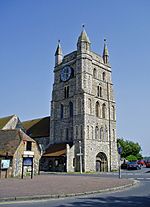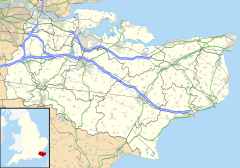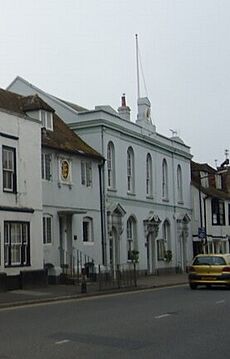New Romney facts for kids
Quick facts for kids New Romney |
|
|---|---|
 The New Romney Church tower in 2007 |
|
 Arms of New Romney |
|
| Population | 6,996 (2011) |
| OS grid reference | TR066249 |
| Civil parish |
|
| District |
|
| Shire county | |
| Region | |
| Country | England |
| Sovereign state | United Kingdom |
| Post town | NEW ROMNEY |
| Postcode district | TN28 |
| Dialling code | 01797 |
| Police | Kent |
| Fire | Kent |
| Ambulance | South East Coast |
| EU Parliament | South East England |
| UK Parliament |
|
New Romney is a historic market town in Kent, England. It sits on the edge of Romney Marsh, which is a large, flat area of farmland. This land was once covered by the sea but has been reclaimed over time.
New Romney was originally a busy sea port. Its harbour was right next to the church. Today, the town is more than a mile from the sea. It is also the main base for the Romney, Hythe and Dymchurch Railway, a popular miniature steam railway.
Contents
Exploring New Romney's Location
New Romney is not much older than the nearby village of Old Romney. However, New Romney was once a very important harbour town. It was located at the mouth of the River Rother.
Understanding the River Rother Estuary
The estuary (where the river meets the sea) of the River Rother was always tricky to sail through. It had many shallow channels and sandbanks. The names of nearby places, Greatstone and Littlestone, might remind us of these sandy areas.
How the Coastline Changed
Another reason for these names could be longshore drift. This is a natural process where shingle and sand move along the coast. Heavier stones gathered in the area now called Greatstone. Much smaller shingle is found in large amounts at Littlestone. Even finer sand is found further east at St Mary's Bay.
A Look Back at New Romney's Past
In the late 1200s, strong storms hit the coast of Romney Marsh. A huge flood in February 1287 almost destroyed New Romney. It also ruined the nearby area of Broomhill. The harbour and town became filled with sand, mud, and other debris. The River Rother even changed its path and started flowing into the sea near Rye.
Why Old Buildings Are Lower Than the Street
The mud and sand were never fully cleared from the town. This is why many old buildings, especially the church, have steps leading down into them from the current street level. It shows how much the ground level has risen over centuries.
New Romney as a Cinque Port
New Romney is one of the original Cinque Ports of England. These were important coastal towns that provided ships and sailors for the King's navy. However, New Romney's importance quickly faded in the 1300s and 1400s after it lost its harbour.
Discoveries About the Town's Beginnings
In 2007, archaeologists studied the town when new drainage pipes were being installed. Their findings gave new information about how the town started and grew in medieval times. The New Romney Town Hall was built much later, in 1702.
New Romney During World War II
During World War II, special floating concrete harbour sections were built. These were called Mulberry Harbours. They were towed across the English Channel to France to help the Allied forces land. One of these harbour pieces can still be seen today. It is stuck in a sandbank off the coast near Littlestone-on-Sea, visible at low tide.
Further along the coast, during Operation PLUTO (Pipe Line Under The Ocean), oil was pumped under the English Channel to France. This oil was vital for the Allied troops.
Local Education in New Romney
New Romney is the biggest town on Romney Marsh. The only secondary school in the area, John Southland's Community Comprehensive School, was founded in 1610. It was renamed The Marsh Academy in August 2007.
Exploring the Town Centre
Like many towns on the marsh, New Romney has an impressive Norman church. This is the Church of St Nicholas, located in the town centre. This church originally stood right by the harbour. Its entrances are several feet below the current ground level. The church is also famous for the boat hooks that can still be seen on its side walls.
Shops and Historic Buildings
New Romney's historic high street has many small and interesting shops. Some businesses closed after a Sainsbury's supermarket opened. However, the town has kept much of its unique feel.
The former almshouses (charitable homes for the poor) on West Street are important historic buildings in Kent. They were started in 1610 by John Southland, a significant local figure. They were rebuilt in 1734. Next to these are Plantagenet House and No 3 Old Stone Cottage. These two buildings were originally one large house built around 1300–1350. Researchers believe it was once the home of the Master of The Hospital of St John the Baptist. This hospital was active by about 1260 and was important until the late 1400s.
Golfing Near New Romney
About three-quarters of a mile north of the town is the links golf course at Littlestone-on-Sea. This golf course was a favourite of Denis Thatcher, who was the husband of former British prime minister Margaret Thatcher. It has also been used many times for the qualifying rounds of The Open Championship, a major golf tournament.
Getting Around New Romney
The Romney, Hythe and Dymchurch Railway has a station at the far east of New Romney. This railway is a major tourist attraction. Until 2015, it was also used by students traveling to school. The station is about three-quarters of a mile east of the historic town centre.
Past Railway Connections
New Romney was once served by the New Romney and Littlestone-On-Sea railway station. This station was part of the Lydd Line. It was located halfway between New Romney and Littlestone-on-Sea. The station had two platforms and a small goods yard. It was originally called New Romney & Littlestone, with "on-Sea" added in 1888.
In 1927, a single railway line was built to connect with the Romney, Hythe and Dymchurch Railway station. This connection was used to deliver coal to the miniature railway. The station closed in 1967 and was replaced by a bus service.
Road and Bus Travel
New Romney is easy to reach by road. The A259 road, which runs from Folkestone to Havant, passes through the town. Several bus services also run to and through New Romney from places like Hastings, Folkestone, and Ashford.
Media and Entertainment
New Romney has a dedicated weekly newspaper, the Kentish Express. This newspaper is published by the KM Group and covers the Romney Marsh area. There is also the Folkestone Herald, which now includes news from the Romney Marsh Herald.
Local Radio Stations
The local radio station for New Romney is KMFM Ashford. It plays county-wide music but includes local adverts for the Marsh area. Other county-wide stations like Heart, Gold, and BBC Radio Kent also serve New Romney.
Cinque Ports Radio 100.2FM is a community radio station for Romney Marsh. It started broadcasting on March 7, 2022. It replaced Shoreline FM, which now broadcasts online.
New Romney on Film
In 1951, a film called Green Grow the Rushes was made in and around New Romney. It starred famous actors like Richard Burton, Roger Livesey, and Honor Blackman. Parts of the film were also shot in nearby St Mary in the Marsh.
Places Named After New Romney
In 1762, a person named Thomas Fairfax, 6th Lord Fairfax of Cameron named the town of Romney in what is now West Virginia in the United States. He named it after the town of New Romney in England.
Symbols of New Romney
 |
|
See also
 In Spanish: New Romney para niños
In Spanish: New Romney para niños



